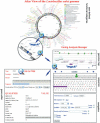AGMIAL: implementing an annotation strategy for prokaryote genomes as a distributed system
- PMID: 16855290
- PMCID: PMC1524909
- DOI: 10.1093/nar/gkl471
AGMIAL: implementing an annotation strategy for prokaryote genomes as a distributed system
Abstract
We have implemented a genome annotation system for prokaryotes called AGMIAL. Our approach embodies a number of key principles. First, expert manual annotators are seen as a critical component of the overall system; user interfaces were cyclically refined to satisfy their needs. Second, the overall process should be orchestrated in terms of a global annotation strategy; this facilitates coordination between a team of annotators and automatic data analysis. Third, the annotation strategy should allow progressive and incremental annotation from a time when only a few draft contigs are available, to when a final finished assembly is produced. The overall architecture employed is modular and extensible, being based on the W3 standard Web services framework. Specialized modules interact with two independent core modules that are used to annotate, respectively, genomic and protein sequences. AGMIAL is currently being used by several INRA laboratories to analyze genomes of bacteria relevant to the food-processing industry, and is distributed under an open source license.
Figures




References
-
- Kunst F., Ogasawara N., Moszer I., Albertini A.M., Alloni G., Azevedo V., Bertero M.G., Bessieres P., et al. The complete genome sequence of the gram-positive bacterium Bacillus subtilis. Nature. 1997;390:249–256. - PubMed
-
- Stein L. Genome annotation: from sequence to biology. Nature Rev. Genet. 2001;2:493–503. - PubMed
-
- Kitano H. Systems biology: a brief overview. Science. 2002;295:1662–1664. - PubMed
-
- Bork P., Dandekar T., Diaz-Lazcoz Y., Eisenhaber F., Huynen M., Yuan Y. Predicting function: from genes to genomes and back. J. Mol. Biol. 1998;283:707–725. - PubMed
-
- Jefery C.J. Moonlighting proteins. Trends Biochem. Sci. 2000;24:8–11. - PubMed

